- Electric and Telecom Plans Free
- Fire and Emergency Plans Free
- Floor Plans Free
- Plant Layout Plans Free
- School and Training Plans Free
- Seating Plans Free
- Security and Access Plans Free
- Site Plans Free
- Sport Field Plans Free
- Cafe and Restaurant Floor Plans $25
- Gym and Spa Area Plans $49
- HVAC Plans $49
- Landscape & Garden $49
- Office Layout Plans $25
- Plumbing and Piping Plans $49
- Reflected Ceiling Plans $49
- Tilt and Turn Windows $25
- Agriculture Infographics $49
- Economy Infographics $25
- Education Infographics $25
- Energy Industry Infographics $25
- Financial Infographics $25
- Green Energy $25
- Management Infographics $25
- Marketing Infographics $25
- Mass Media Infographics $25
- Oil and Gas $25
- Politics Infographics $25
- Travel Infographics $25
- Business Process Diagrams Free
- Business Process Mapping Free
- Classic Business Process Modeling Free
- Cross-Functional Flowcharts Free
- Event-driven Process Chain Diagrams Free
- IDEF Business Process Diagrams Free
- Logistics Flow Charts Free
- Workflow Diagrams Free
- Business Intelligence Dashboard $99
- Business Process Workflow Diagrams $49
- Healthcare Management Workflow Diagrams $49
- Logistic Dashboard $49
- ConceptDraw Dashboard for Facebook Free
- Mind Map Exchange Free
- MindTweet Free
- Note Exchange Free
- Project Exchange Free
- Social Media Response Free
- Active Directory Diagrams Free
- AWS Architecture Diagrams Free
- Azure Architecture Free
- Cisco Network Diagrams Free
- Cisco Networking Free
- Cloud Computing Diagrams Free
- Computer Network Diagrams Free
- Google Cloud Platform Free
- Interactive Voice Response Diagrams Free
- Network Layout Floor Plans Free
- Network Security Diagrams Free
- Rack Diagrams Free
- Telecommunication Network Diagrams Free
- Vehicular Networking Free
- Wireless Networks Free
- Internet of Things $30
- Comparison Dashboard Free
- Composition Dashboard Free
- Correlation Dashboard Free
- Frequency Distribution Dashboard Free
- Meter Dashboard Free
- Spatial Dashboard Free
- Status Dashboard Free
- Time Series Dashboard Free
- Basic Circle-Spoke Diagrams Free
- Basic Circular Arrows Diagrams Free
- Basic Venn Diagrams Free
- Block Diagrams Free
- Concept Maps Free
- Family Tree Free
- Flowcharts Free
- Basic Area Charts Free
- Basic Bar Graphs Free
- Basic Divided Bar Diagrams Free
- Basic Histograms Free
- Basic Line Graphs Free
- Basic Picture Graphs Free
- Basic Pie Charts Free
- Basic Scatter Diagrams Free
- Health Informatics Free
- Allergology $49
- Biomedicine $49
- Genogram $25
- Health Sciences $25
- Human Anatomy $25
- Immunology $49
- Medical Illustrations $25
- Medical Mycology $49
- Medical Virology $49
- Pharmacy Illustrations $25
- Aerospace and Transport Free
- Artwork Free
- Audio, Video, Media Free
- Business and Finance Free
- Computers and Communications Free
- Holiday Free
- Manufacturing and Maintenance Free
- Nature Free
- People Free
- Presentation Clipart Free
- Safety and Security Free
- Analog Electronics Free
- Audio and Video Connectors Free
- Basic Circuit Diagrams Free
- Chemical and Process Engineering Free
- Digital Electronics Free
- Electrical Engineering Free
- Electron Tube Circuits Free
- Electronic Block Diagrams Free
- Fault Tree Analysis Diagrams Free
- GHS Hazard Pictograms Free
- Home Automation and Wiring Free
- Mechanical Engineering Free
- One-line Diagrams Free
- Power Сircuits Free
- Specification and Description Language (SDL) Free
- Telecom and AV Circuits Free
- Transport Hazard Pictograms Free
- Data-driven Infographics Free
- Pictorial Infographics Free
- Spatial Infographics Free
- Typography Infographics Free
- Calendars Free
- Decision Making Free
- Enterprise Architecture Diagrams Free
- Fishbone Diagrams Free
- Organizational Charts Free
- Plan-Do-Check-Act (PDCA) Free
- Seven Management and Planning Tools Free
- SWOT and TOWS Matrix Diagrams Free
- Timeline Diagrams Free
- 25 Typical Orgcharts $25
- Business Diagrams $49
- Critical Infrastructure Sectors $35
- CRM Center Dashboard $49
- Environmental, Social, and Corporate Governance $25
- HR Dashboard $49
- HR Flowcharts $25
- Public Utilities $25
- Stakeholder Onion Diagrams $49
- Sustainable Development $25
- Australia Map Free
- Continent Maps Free
- Directional Maps Free
- Germany Map Free
- Metro Map Free
- UK Map Free
- USA Maps Free
- Customer Journey Mapping Free
- Marketing Diagrams Free
- Matrices Free
- Pyramid Diagrams Free
- Sales Dashboard Free
- Sales Flowcharts Free
- Target and Circular Diagrams Free
- Funnel Diagrams $25
- Business Diagrams Package $230
- Business Infographics Package $130
- Business Management Package $367
- Education Package $160
- Health Package $180
- Project Management Package $158
- Cash Flow Reports Free
- Current Activities Reports Free
- Custom Excel Report Free
- Knowledge Reports Free
- MINDMAP Reports Free
- Overview Reports Free
- PM Agile Free
- PM Dashboards Free
- PM Docs Free
- PM Easy Free
- PM Meetings Free
- PM Planning Free
- PM Presentations Free
- PM Response Free
- Resource Usage Reports Free
- Visual Reports Free
- Kanban Board $25
- MindMap Diagrams $99
- PM Mind Maps and Tables $25
- Project Diagrams $49
- Scrum Workflow $49
- House of Quality Free
- Quality Mind Map Free
- Total Quality Management TQM Diagrams Free
- Value Stream Mapping Free
- Seven Basic Tools of Quality $25
- Astronomy Free
- Biology Free
- Chemistry Free
- Language Learning Free
- Mathematics Free
- Physics Free
- Piano Sheet Music Free
- Android User Interface Free
- Class Hierarchy Tree Free
- Data Flow Diagrams (DFD) Free
- DOM Tree Free
- Entity-Relationship Diagram (ERD) Free
- EXPRESS-G data Modeling Diagram Free
- IDEF0 Diagrams Free
- iPhone User Interface Free
- Jackson Structured Programming (JSP) Diagrams Free
- macOS User Interface Free
- Object-Role Modeling (ORM) Diagrams Free
- Rapid UML Free
- SYSML Free
- Website Wireframe Free
- Windows 10 User Interface Free
- ATM UML Diagrams $25
Rack Diagrams
Any computer network can be also called a digital network. Such network allows sharing the needed resources with the networked computing devices, exchanging data with each other by using a so-called "data link". There are many connections between the nodes in the computer networks that are known to be established by using either wireless media or a cable media.
Computer networks are known to be supporting a lot of different services and applications. They can be different in terms of the transmission medium that is used for carrying their signals, communications protocols for organizing the necessary network traffic, topology, organizational intent and the network's size. One of the best-known computer networks is Internet.
Different network computer devices can route, terminate and originate the data network. Such network is known for including hosts such as phones, servers, networking hardware and personal computers. Two of the listed devices can be networked together in the case one of them can exchange the information with another.
If there is a 19" network equipment, a Rack diagram is a drawing that can help to design as well as to document it. Once the equipment is purchased, rack diagrams can help you to determine which one needs to be bought. It is also possible to store such data as location and serial number.
The Rack Diagrams solution can be used while working in the ConceptDraw DIAGRAM diagramming and drawing software in order to create the necessary Rack diagrams. Choosing any of the 54 vector shapes from its stencil library, you can use the Rack Diagrams solution for drawing various types of Rack diagrams or Server rack diagrams visualizing 19" rack mounted computers and servers.
The Rack Diagrams solution, additionally including a collection of samples and a quick-start template, can be useful for many users of the ConceptDraw DIAGRAM who deal with computer networks, such as IT specialists; computer, network and telecommunication engineers; software engineers, technical writers, IT managers, system administrators, technical support, webmasters, system architects and engineers.
-
Install this solution Free -
What I need to get started -
Solution Requirements - This solution requires the following products to be installed:
ConceptDraw DIAGRAM v18 - This solution requires the following products to be installed:
-
Compatibility - Sonoma (14), Sonoma (15)
MS Windows 10, 11 - Sonoma (14), Sonoma (15)
-
Support for this Solution -
Helpdesk
Design Elements — Rack Diagrams

Related News:
Five Solutions for ConceptDraw DIAGRAM, They Can Be Found in the Computer and Networks Area
Examples
There are a few samples that you see on this page which were created in the ConceptDraw DIAGRAM application by using the Rack Diagrams solution. Some of the solution's capabilities as well as the professional results which you can achieve are all demonstrated here on this page.
All source documents are vector graphic documents which are always available for modifying, reviewing and/or converting to many different formats, such as MS PowerPoint, PDF file, MS Visio, and many other graphic ones from the ConceptDraw Solution Park or ConceptDraw STORE. The Rack Diagrams solution is available to all ConceptDraw DIAGRAM users to get installed and used while working in the ConceptDraw DIAGRAM diagramming and drawing software.
Example 1: Application Server Rack Diagram
This diagram was created in ConceptDraw DIAGRAM using the Rack Diagrams Library from the Rack Diagrams solution. An experienced user spent 10 minutes creating this sample.
This sample shows an Application server rack diagram. An application server is a software framework represented as a set of components that can be used by software developers allowing them to develop the web applications and construct dynamic pages, and it is also a server that runs these applications. Besides, some application servers can realize a lot of other functions, such as for example fail-over, clustering, load-balancing, and others. In any case, the main function of an application server is an effective execution of varied procedures, scripts, programs, and subprograms for its applications support. A given Rack diagram visualizes the rack mounting of computer and network equipment that is often used as a server and represents it as a frontal view of the rack with equipment installed. ConceptDraw DIAGRAM software extended with the Rack Diagrams solution can be successfully used for racking and drawing various professional Rack diagrams and Server Rack diagrams.
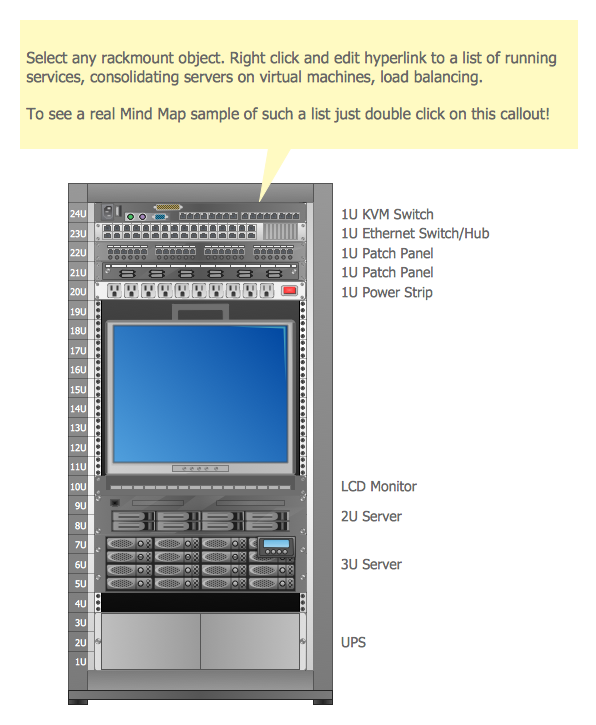
Example 2: Rack Diagram
This diagram was created in ConceptDraw DIAGRAM using the Rack Diagrams Library from the Rack Diagrams Solution. An experienced user spent 20 minutes creating this sample.
This example designed in the ConceptDraw DIAGRAM software illustrates the network server rack diagram. ConceptDraw DIAGRAM software is ideal for constructing Rack diagrams visualizing the rack mounting of computer hardware and network equipment (rack units, switches, routers, servers, monitors, patch panels, etc.). The variety of tools presented at the Rack Diagrams solution from the Computer and Networks area of ConceptDraw Solution Park allow you to design and document the network rack server equipment, to easily draw the frontal view of a 19-inch rack with equipment installed. It is one of the most useful and convenient solutions on the rack solutions software market, useful for equipping the corporate server rooms, data centers, ISP facilities, etc. The Rack diagrams are typically used for racking, when choosing which computer equipment or racks to buy, and to virtually see if a particular configuration works, without having to immediately go through a physical installation.

Example 3: Rack Diagram — Virtualized Computer Center
This diagram was created in ConceptDraw DIAGRAM using the Rack Diagrams Library from the Rack Diagrams Solution. An experienced user spent 10 minutes creating this sample.
This Rack diagram sample represents a Virtualized Computer Center and was drawn on the base of a picture illustrating the article "Virtualization in general, for technicians and business people" from the Banym's Blog by Dominik Zajac. The virtualization is an offering of a set of computing resources or even their logical union, which is abstracted from the hardware implementation, but nevertheless provides logical isolation from each other the computing processes running on the same physical resource. As for the design of any Rack diagram in ConceptDraw DIAGRAM, it is quite simple - drag the metal frame icon from the Rack Diagrams library offered by the Rack Diagrams solution at ConceptDraw STORE and also devices that you need to fill the rack from the same area. The library offers you a wide choice - the objects depicting various hardware devices such as servers, routers, raid, UPS, hard disk drives, modems and other electronic equipment.
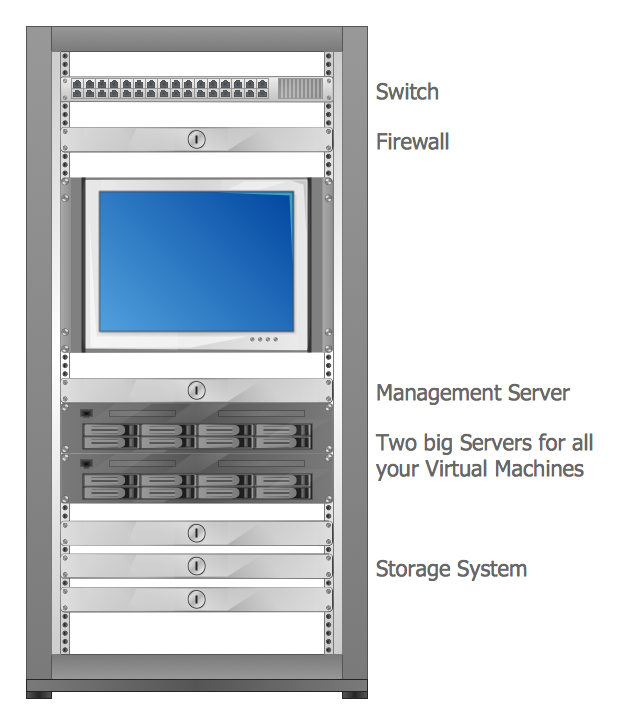
Example 4: Rack Diagram — Rackunit
This diagram was created in ConceptDraw DIAGRAM using the Rack Diagrams Library from the Rack Diagrams Solution. An experienced user spent 5 minutes creating this sample.
This sample diagram shows a Rack unit (RU or U) designed to be mount in a 19-inch rack. A Rack unit is a unit of measure that describes the height of specialized telecommunication and IT equipment, which is located inside the rack. The size of a piece of rack-mounted equipment is denoted as a numerical value and U, so 1U is one rack unit, 2U signifies two rack units, and so on. Sometimes, you can meet also the half-rack units, such as 1.5U, 2.5U, and so on. The height of one rack unit equals 1.75 inches or 4.445 cm. The ConceptDraw's Rack Diagrams solution includes the Rack Diagrams library, in which for each rack unit and half-rack unit component a special vector object is provided. Use also other predesigned objects of the network equipment from this library to document your rack system quickly and professionally, and to visualize it on a Rack diagram.

Example 5: Typical Server Rack Diagram
This diagram was created in ConceptDraw DIAGRAM using the Rack Diagrams Library from the Rack Diagrams Solution. An experienced user spent 10 minutes creating this sample.
This sample shows the Rack diagram of a typical server configuration. The Rack diagrams are widely used when choosing and buying racks and different equipment to complete them, and they help to visualize the equipment as it stands on the racks. By the server is implied a computer model designed to host software applications that are in high demand of the network environment. Typically, the servers need possess such characteristics as reliability, availability, fault tolerance, serviceability, rapidity of the network connections, as well as redundancy in power network connections, supplies, and storage. Design with the consummate ease your own professional looking Server rack diagrams and Rack diagrams in the ConceptDraw DIAGRAM diagramming software using the ready-to-use equipment objects pre-made according to the industry-standard measurements and arranging them in a required way. The resulting diagrams are perfect for using as projects before assembling the rack and as reports illustrating result as well.
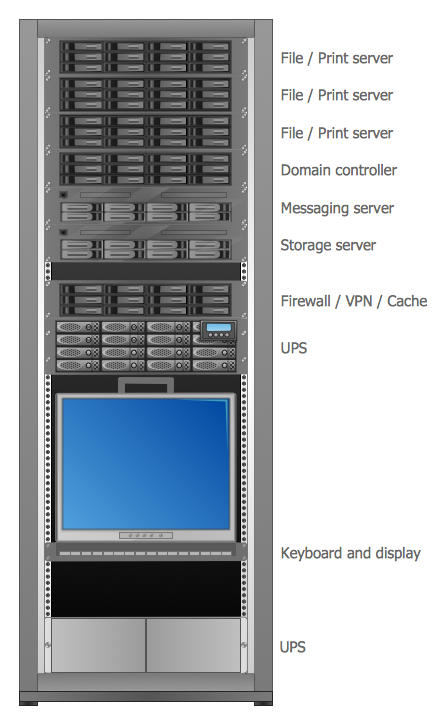
Example 6: Rack Diagram — Servers
This diagram was created in ConceptDraw DIAGRAM using the Rack Diagrams Library from the Rack Diagrams solution. An experienced user spent 10 minutes creating this sample.
This Mind Map example visualizes the structure and functionality of internal and external enterprise server hardware and software. The form of a Mind Map is useful and visual to represent different kinds of information, including concerning the servers. The server is a system that includes required computer hardware and software, and reacts on the computer network requests regarding the provision of network services. The composition of hardware and requirements for hardware may vary considerably according to the servers’ goals and assignments, in this regard before installing equipment and cabling in a server rack it is recommended to make a detailed plan and to visualize it in a form of a diagram, because the space within a rack is limited and the diagram helps to determine the optimal rack's size and configuration that corresponds to your needs, requirements, and budget. So, in addition to Mind Map, you can make the suitable Rack plan using the ConceptDraw DIAGRAM software.
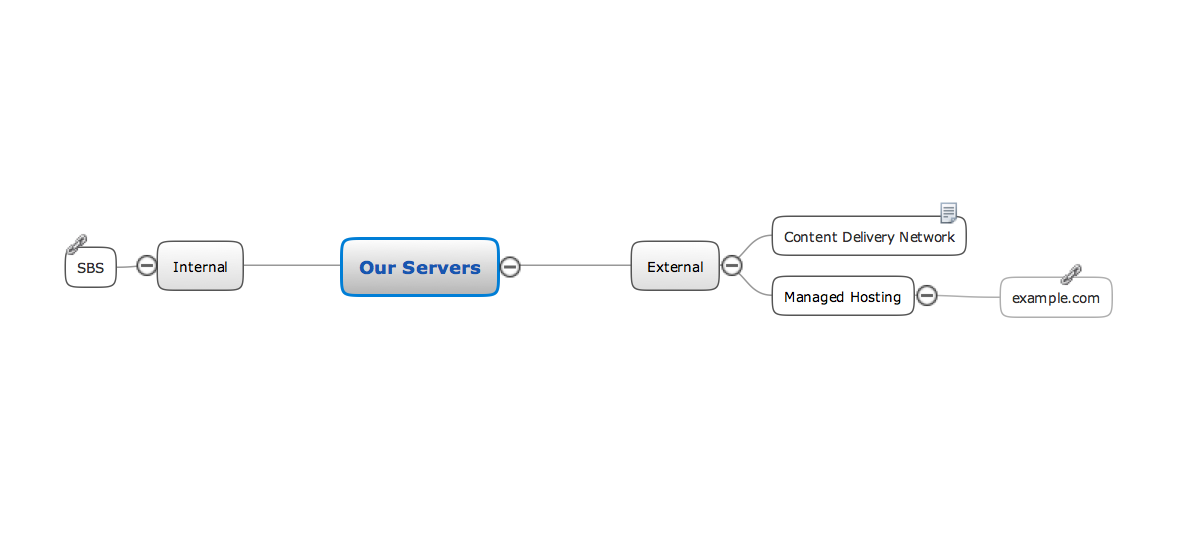
Template: Rack Diagram
This diagram was created in ConceptDraw DIAGRAM using the Rack Diagrams Library from the Rack Diagrams solution. An experienced user spent 10 minutes creating this sample.
This example illustrates the Rack diagram template that is included in the ConceptDraw's Rack Diagrams solution and available for use as a quick-start from the ConceptDraw STORE. Drawing a Rack diagram to visualize the mounting of computer and network equipment to the rack is the easiest on the base of this template. In addition, supplied with helpful comments, it facilitates the process of drawing to the point that it takes only a few minutes of your time. You are free to modify and update the rack, to change its size and to show or hide the height scale as you like, to customize the configuration, to mount new equipment into the rack using the predesigned vector objects from the solution’s library and also to connect them with smart connectors. The rack's size typically equals 42U that corresponds around 6 feet of equipment, but there are also used the half-height racks of 18-22U holding over 3 feet.
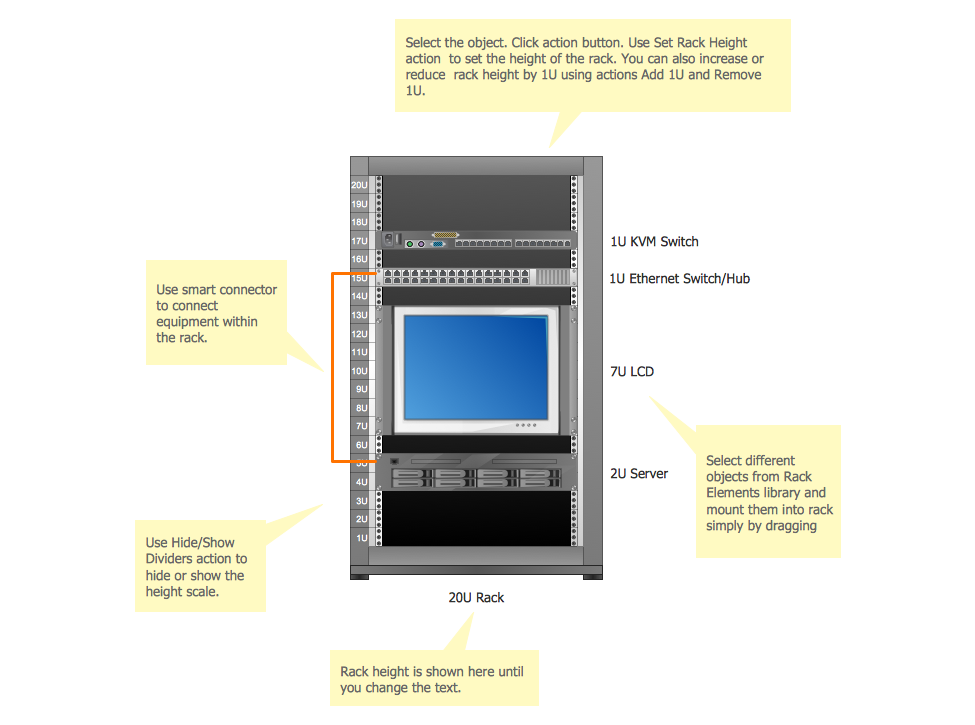
Inside
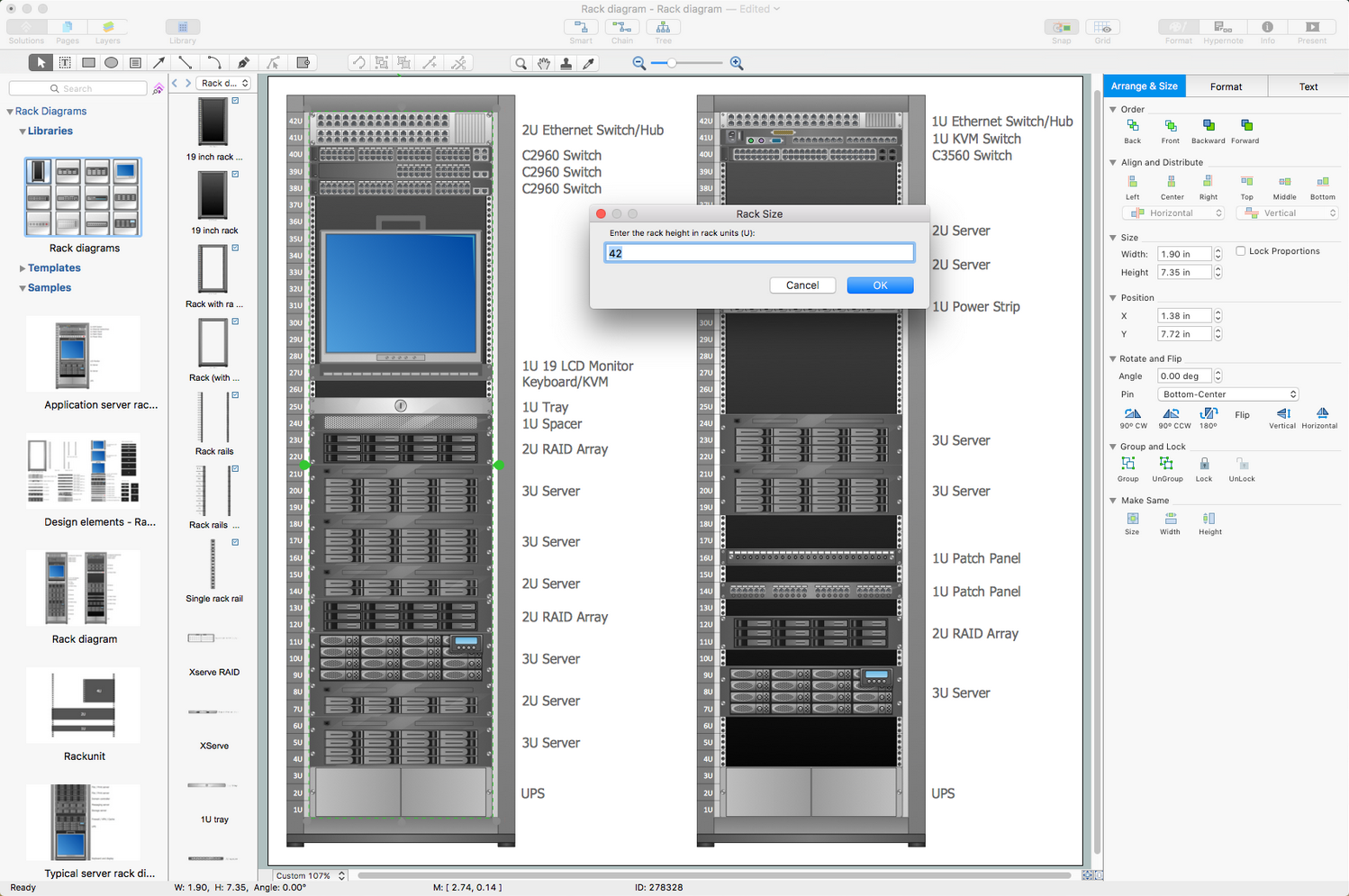

What I Need to Get Started
Both ConceptDraw DIAGRAM diagramming and drawing software and the Rack Diagrams solution can help creating the rack diagrams you need. The Rack Diagrams solution can be found in the Computer and Networks area of ConceptDraw STORE application that can be downloaded from this site. Make sure that both ConceptDraw DIAGRAM and ConceptDraw STORE applications are installed on your computer before you get started.
How to install
After ConceptDraw STORE and ConceptDraw DIAGRAM are downloaded and installed, you can install the Rack Diagrams solution from the ConceptDraw STORE.
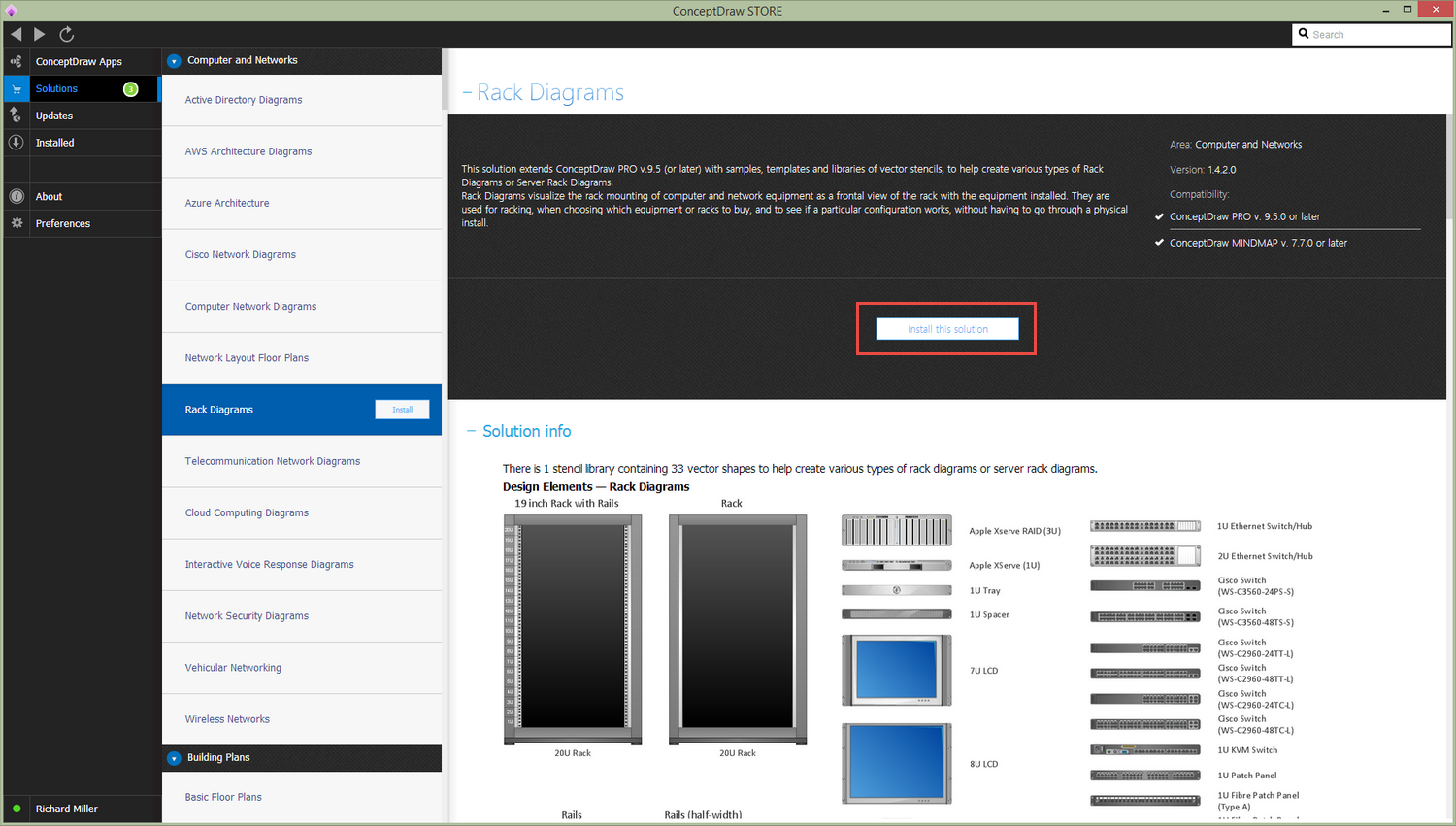
Start using
To make sure that you are doing it all right, use the pre-designed symbols from the stencil libraries from the solution to make your drawings look smart and professional. Also, the pre-made examples from this solution can be used as drafts so your own drawings can be based on them. Using the samples, you can always change their structures, colors and data.
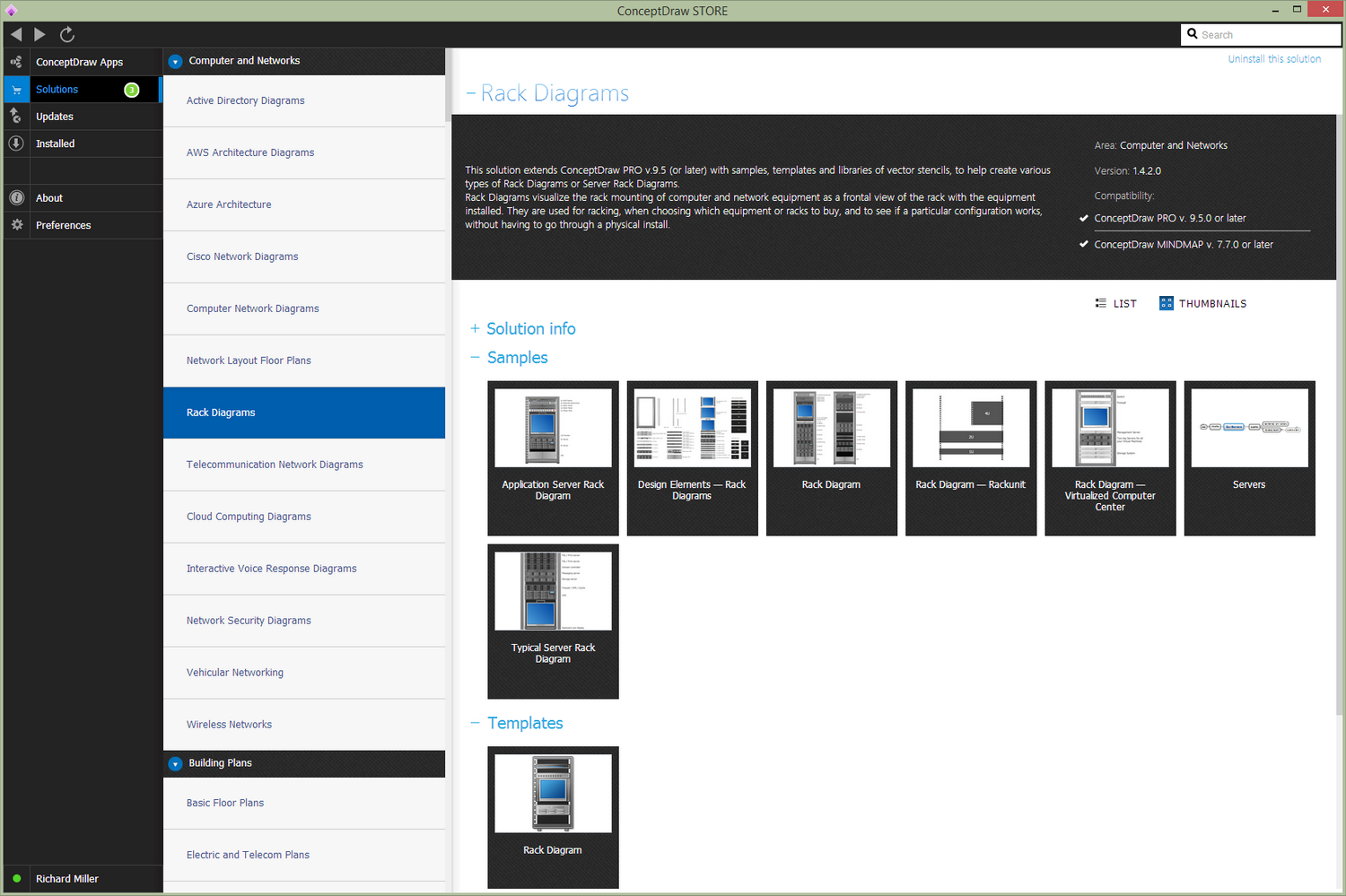
Rack Diagram
Most of us have heard tales or seen pictures of the very first examples of computer hardware systems — hulking machinery that filled entire rooms, despite their (compared to today's standards) relatively small processing power. For instance, the appropriately named Colossus computer, designed to aid codebreakers during WWII, stood 7ft high by 17ft wide by 11ft deep, and weighed in at an impressive five tonnes.
In the modern era, the most powerful computer systems still require the services of entire rooms, or even whole buildings; the difference of course is that the output of computational processes and calculations has increased exponentially. Often termed as server rooms or data centres, these locations are capable of storing a vast array of separate hardware technologies, that run in sequence and as a complement to each other. Let's take a look at the sort of components that make up a contemporary computer system, and what they are used for:
- Servers — a broad term generally used to describe a piece of hardware that stores large amounts of data, capable of being accessed by multiple clients.
- Network switches — a hub that connects multiple devices in a network to facilitate communication between them.
- RAID — standing for redundant array of hard disk drives, this is the term given to a collection of physical data drives that are logically combined to assist with data storage and recovery.
- RAIM — a redundant array of independent memory uses the same theory as RAID to prevent memory failures and to keep a system operating continuously.
- UPS — an uninterruptible power supply acts as a backup in case of main power malfunction.
- NAS — network attached storage is a specialized form of server that provides solely file-based data storage to other devices on a network.

An example from the ConceptDraw DIAGRAM Rack Diagrams solution of the kind of design elements that can be used in a diagram
A typical data centre will house multiple instances of each of these devices, as well as other common hardware such as monitors or printers, and a whole host of technology that allows network nodes to interact — routers, repeaters, and KVM switches to name but a few. To house such an assortment in an efficient and logical manner, a technical standard has been devised for server racks, allowing rows of hardware to be stacked upon each other, while making it easy for new hardware to added where space is available. These free standing storage spaces come in 19-inch and 23-inch wide variants — height is measured in terms of 'rack units', a typical structure being 42 rack units tall.

A typical rack diagram, designed using ConceptDraw DIAGRAM.
Before installing what can be a complicated and extensive array of hardware, most industries will perform a planning stage, that involves careful and accurate representation of the finished data center in diagram form. The benefits are clear — it's an opportunity to troubleshoot any logistical problems without the physical labor of constructing and deconstructing the server racks; inefficiencies can be spotted before they show up in real-time. For the various types of company that have need for a server room — telecommunication systems, online gaming hosts, entertainment industries and cloud services, for example — a rack diagram can be a really valuable time-saver.
It's important that the software used to create a rack diagram contains templates that adhere to industry standards, and provides a wide selection of device icons to cover multiple styles of arrangement for a variety of network situations. ConceptDraw DIAGRAM extended with the Rack Diagrams solution offers comprehensive support in this area, incorporating a selection of samples and vector image libraries that allow the user to construct a rack diagram of any complexity in just a matter of moments.
With help videos, how-to guides, and of course the templates offered within the Rack Diagrams solutions, it's never been easier to put together professional looking designs that accurately describe possibilities for complex networks and data farms.